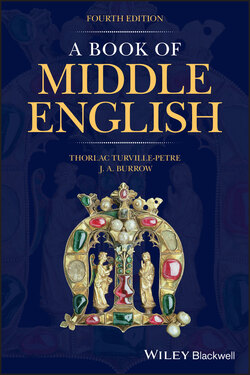Читать книгу A Book of Middle English - J. A. Burrow - Страница 40
4.3.7 Demonstratives
ОглавлениеAs þe became the invariable form of the definite article, þat, originally its neuter form, became restricted to demonstrative use for all genders, though in early texts it is used only with singular inanimate nouns, as in al ðat iren, ‘all that iron’, 1/32–3. At first its plural is naturally that of the definite article, þa/þo, ‘those’, used for all genders: þa men, ‘those men’, 1/17, of þat stering or of þoo sterynges, 6/50.
The plural demonstrative ‘these’, þās or þs in Old English, has a range of forms in Early Middle English, as in þos word, ‘these words’, 2/139, þeose bemeres, ‘these trumpeters’, 4/8–9, þes rikeneres, ‘these auditors’, 4/46–7. In addition, a new plural þise was coined on the basis of the singular þis. Eventually two sets of forms were distinguished in sense, so that þese and þise became the forms for ‘these’, as in þise gentyle kniʒtes, ‘these noble knights’, 9/42, while þase and þose became the forms for ‘those’, as in þose traytoures, 8/77, and so displaced the earlier þa/þo as the plural of þat. In Northern texts only, the word for ‘these’ is thir/ther (15/145), of obscure origin.
The singular þis is generally undeclined, though some inflexional forms remain in Early Middle English: for example dative masculine þissen, 3/111, nominative feminine þos, 2/41.
